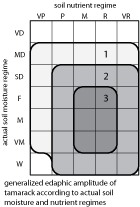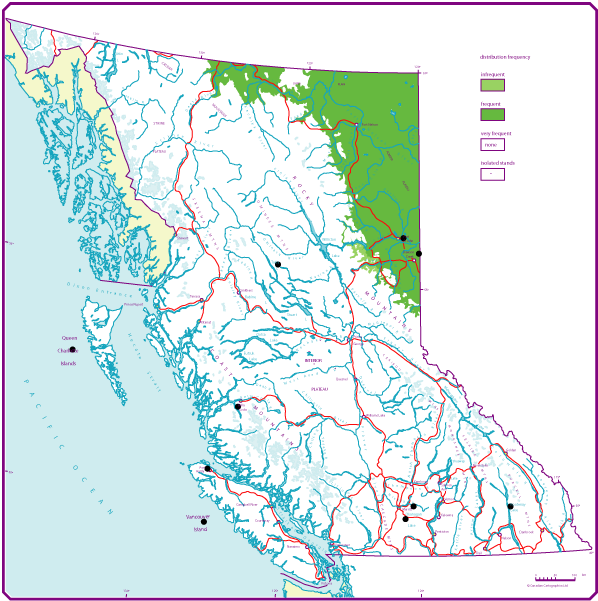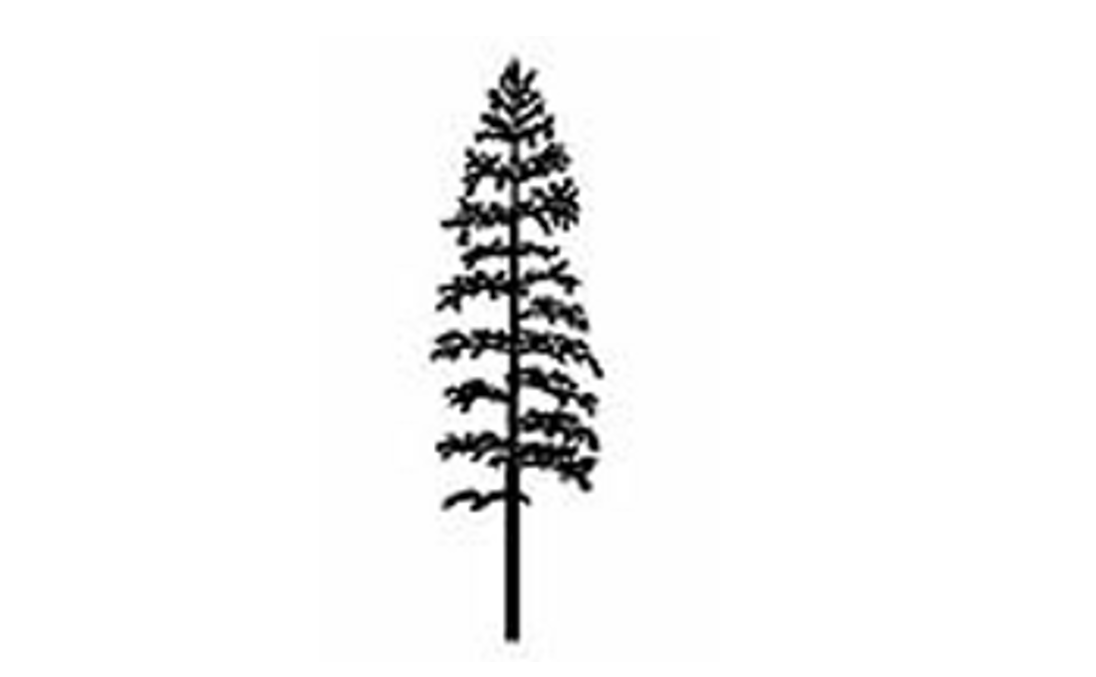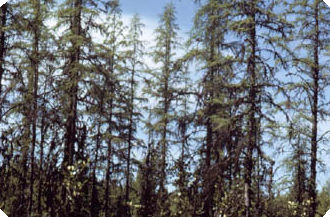Tamarack
Tamarack (Lt) - Larix laricana
Tamarack is a small- to medium-sized (rarely >35m tall) deciduous conifer with a rugged, irregular appearance, sparse crown, and reddish-brown, scaly bark. The heavy durable wood is used (outside British Columbia) principally for pulp, but also for posts, poles, rough lumber, and fuel.
On this page
- Geographic range and ecological amplitudes
- Tolerances and damaging agents
- Silvical characteristics
- Genetics and notes
Geographic range and ecological amplitudes
Geographic range
Geographic amplitude:
North American transcontinental-incomplete
Distribution in western North America:
north and central in the Cordilleran region
Ecological amplitudes
Climatic amplitude:
subarctic - montane boreal - (cool temperate)
Orographic amplitude
(submontane) - montane
Occurrence in biogeoclimatic zones:
BWBS, (SBS)
Tamarack is one of a few coniferous trees most successfully growing in climates with a short growing season; it is adapted to a very cold (Siberian-like) boreal climate, partly by way of being deciduous.
Edaphic amplitude

Range of soil moisture regimes:
(moderately dry) - slightly dry - fresh - moist - very moist - wet
Range of soil nutrient regimes:
(very poor) - poor - medium - rich - very rich; calciphytic
The nutrient amplitude of tamarack is related to moderately and weakly acid soils. On wetland sites, it occurs mainly in circumneutral (pH >6.0) or even slightly alkaline soils. On such sites, decaying wood microsites are acidic; however, the underlying soil horizons remain circumneutral. Tamarack also grows on upland sites where the soils are derived from limestone, dolomite, or even calcium-rich igneous rocks. Therefore, it could be concluded that tamarack is a calciphytic species.
Tolerances and damaging agents
Root system characteristics
Tamarack typically has a shallow, compact, root system that develops in the upper 30cm of soil. On well-drained sites, roots may spread over a length greater in radius than the tree height but they are only 30cm to 60cm deep; horizontal roots of larger trees bend sharply from the trunks. Trees on sandy upland sites have a platelike rooting habit; few roots reach below a 30cm depth and taproots are rare. On wet sites tamarack roots are usually stringy with no side branches. Wetland tamaracks, in particular, have wide roots systems and do not form taproots. As the moss layer deepens, new roots develop on the stem above the original root collar, and growth of old roots nearly ceases. Tamarack roots are associated with both ecto- and endo-mycorrhizae.
| Tolerance to | Tolerance class | Comments |
|---|---|---|
| Low light | L | A very shade-intolerant, exposure-requiring species. |
| Frost | H | Tolerates frozen (permafrost) soils and late-spring and early-fall frost. |
| Heat | M | not a concern in boreal climates |
| Water deficit | M | |
| Water surplus | H | Tolerates flooding, high water table, and strongly fluctuating water table. |
| Nutrient (mainly N) deficiency | M | Absent on very poor sites if the soil is acid, infrequent on very poor sites if the soil is weakly acid or circumneutral. |
| Damaging agent | Resistance class | Comments |
|---|---|---|
| Snow | H | probably due to sparse crown and deciduous nature |
| Wind | L – H | low resistance on wet sites, medium resistance on upland sites. |
| risk class | ||
|---|---|---|
| Fire | M | Susceptible to fire in the young stage. |
| Insect | M | Larch sawfly, larch casebearer. |
| Fungi | L | Red ring rot; Armillaria root disease. |
Associated tree species and successional role
In British Columbia, tamarack typically occurs in small, even-aged stands, either of pure or mixed-species. Tamarack is often a pioneer species (primary succession) and a minor component in stands in minerotrophic wetlands; it may be present in early and intermediate stages of secondary succession on upland sites.
| Associated tree species |
Occurance class | Major area of occurance |
|---|---|---|
| Black spruce | M | Upland and wetland BWBS sites |
| Lodgepole pine | L | Upland BWBS sites |
| White spruce (and hybrids) | L | Upland BWBS sites |
Genetics and notes
Genetics
Tamarack shows much genetic variation. The species is considered to have a clinal pattern of variation, however, no races or ecotypes are presently recognized. Little information is available on intraspecific hybridization in tamarack, but careful selection and breeding may result in substantial genetic improvement.
Although tamarack has been little used in interspecific hybridization, it has been crossed with two other species of the Section Pauciseriales — Japanese larch (Larix leptolepis (Sieb. and Zucc.) Gord.) and European larch (L. decidua Mill.). A Section is a taxonomic grouping of species within a genus. The tamarack-Japanese larch hybrid is especially promising because it combines rapid growth with adaptability to shorter growing seasons. Although crosses between tamarack and the remaining species of the Section — Dahurian larch (L. gmelini(Rupr.) Rupr.) and Siberian larch (L. sibirica (Münchh.) Ledeb.) — seem feasible, apparently none has yet been produced.
Tamarack in Alaska was once named as a separate species (Larix alaskensis W. Wight) and later reduced to a variety (L. laricina var. alaskensis (W. Wight) Raup), but the Alaska variety is no longer accepted.
Notes
Tamarack is a potentially valuable timber crop species in pure or mixed-species stands in the BWBS zone, especially on poorly drained, waterlogged sites, because of its superior early growth compared to black spruce. It requires full light for continued growth and development; therefore, it must be maintained as an overstory component in mixed-species stands. More detailed silvics information is given by:
Johnston, W.F. 1990. Larix laricina. Pp. 141-151 in R.M. Burns and B.H. Honkala (technical coordinators) Silvics of North America, Vol. 1. Agri. Handbook 654, USDA For. Serv., Washington, D.C.
Schmidt, W.C. and K. J. McDonald (compilers) 1995. Ecology and management of Larix forests: a look ahead. Proceedings of an International Symposium, Whitefish, Montana, October, 5-9, 1992. GTR-INT-319, USDA For. Serv., Intermountain Research Station, Ogden, Utah.



